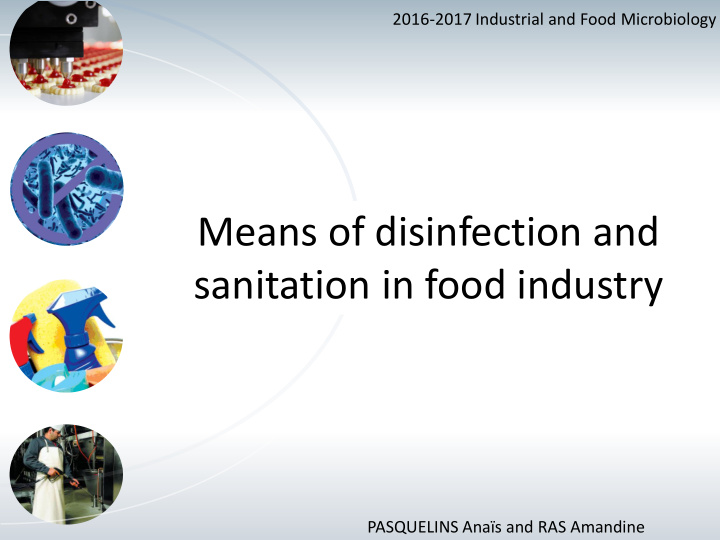



2016-2017 Industrial and Food Microbiology Means of disinfection and sanitation in food industry PASQUELINS Anaïs and RAS Amandine
Introduction • Contamination invisible to the naked eye • Avoiding food-borne diseases • Doing some prevention What do disinfection and sanitation mean? Which processes or products are used? What is the main problem? Is there an alternative?
Table of contents I) Definition a)Disinfection b) Sanitation II) Chemical disinfection – chemical sanitation a) hypochlorite b) chlorine dioxide c) Iodophors d) Peroxyacetic acids e) Quaternary ammonium compounds III) Sanitizers resistance IV) Alternative a) Enzyme products, CryogenicsDry and Dry saturated steam b) Ultrasounds, Ozone, Pulsed light
Definition Disinfection • Elimination or the inhibition of microorganisms in a place, on an object or on the external surface of the human body • To destroy or irreversibly inactivate specified infectious fungi and bacteria, present in the appliances and packaging but not necessarily the spores, on hard surfaces
Definition Sanitation • Promotion of hygiene and prevention of disease by maintenance of sanitary conditions, food handlers, and food processing and equipment • To reduce the number of harmful microorganisms, to a number safe to human health • To minimize them to a number considered as safety standard without altering the product’s quality or its safety
Chemical disinfection chemical sanitation • Using of chemicals : sanitizers – disinfectants • Very common way to the disinfection and sanitation in food industries • Process of disinfection – sanitation is part of a series of steps : - gross clean/preparation - pre-rince - detergent application - post-rinsing - disinfection and terminal rinsing concludes the hygiene process • Diversity of sanitizing chemicals
Hypochlorite Effects: • damage the outer membrane broad microbial mortality • inhibit cellular enzymes and destroy DNA Conditions: 5<pH<7 Advantages : very reactive, low cost, ease of manufacturing Drawback : • Resistance of spores • Corrosiveness to metals • Health concerns • Environmental contamination
Chlorine dioxide • Effective against bacteria, fungi and viruses • Oxidizer : react with the proteins and fatty acids within the cel membrane, resulting in loss of permeability control and disruption of protein synthesis Conditions : 6<pH<10 Advantages : • Effective with lower concentrations • Reacts more selectively with compounds present in microbial • Environmental friendly
Iodophors • Effective sanitizers and disinfectant • Effect : - they attach to the sulfurs of proteins such as cysteine, causing inactivation and cell wall damage - sustained-release effect : continuous microbial mortality Conditions : pH acidic Advantage : environmental friendly Drawback : iodine compounds easily stain many surfaces, particularly plastics
Peroxyacetic acids (PAA) • Effective sanitizer against many microorganisms, their spores and biofilms • Effect : Mortality is produced by the disruption of chemical bonds within the cell membrane. • Frequently paired with stabilized hydrogen peroxide Advantage : • environmental friendly • less corrosive to equipment than hypochlorites Drawback : • Loss of activity at neutral pH • concentrated PAA can present a safety hazard
Quaternary ammonium compounds (QACs) • Effective against a wide range of microbes • Effect : The positively charged cations in the compounds bind with the acidic phospholipids in the microbial cell wall blocks the uptake of nutrients into the microbial cell and prevents the discharge of waste Advantage : odorless, nonstaining, noncorrosive and relatively nontoxic to users Drawback : • Ineffective against spores • heavy soil will decrease QAC activity significantly
How to choose the good one? Ideal sanitizers characteristics : • Destroy vegetative mircoorganisms • Work well in different environment • Dissolve in water • Inexpensive, easy to use, readily available • Should not irritate skin • Should not have offensive odor
Sanitizers resistance • Missed or resistant strains • Proliferation of immunity • Products lose their effectiveness • Choose the appropriate product
Alternative • Enzyme products Less aggressive, Gain in water and time, Efficient and low temperature and low concentration • CryogenicsDry Uses cold, Effective without chemicals products, No effective for vegetables industry • Dry saturated steam No residues, Little efficient if too dirty
Alternative • Ultrasounds Bath vibration removes dirt, Treats all materials, Used in the dairy and meat industry • Ozone Kills bacteria such as E coli, salmonella, listeria • Pulsed light Intense light destroys bacteria Between 200 nm in the ultraviolet and 1 mm in the near infrared
Conclusion • Alternative methods less use by compagnies, because of price 20 to 30% more expensive • Sanitation Stantard Operating Procedures are mandatory for food industry in the US • Sanitation Performance Standards (SPS)
Thank you for your attention !
Recommend
More recommend